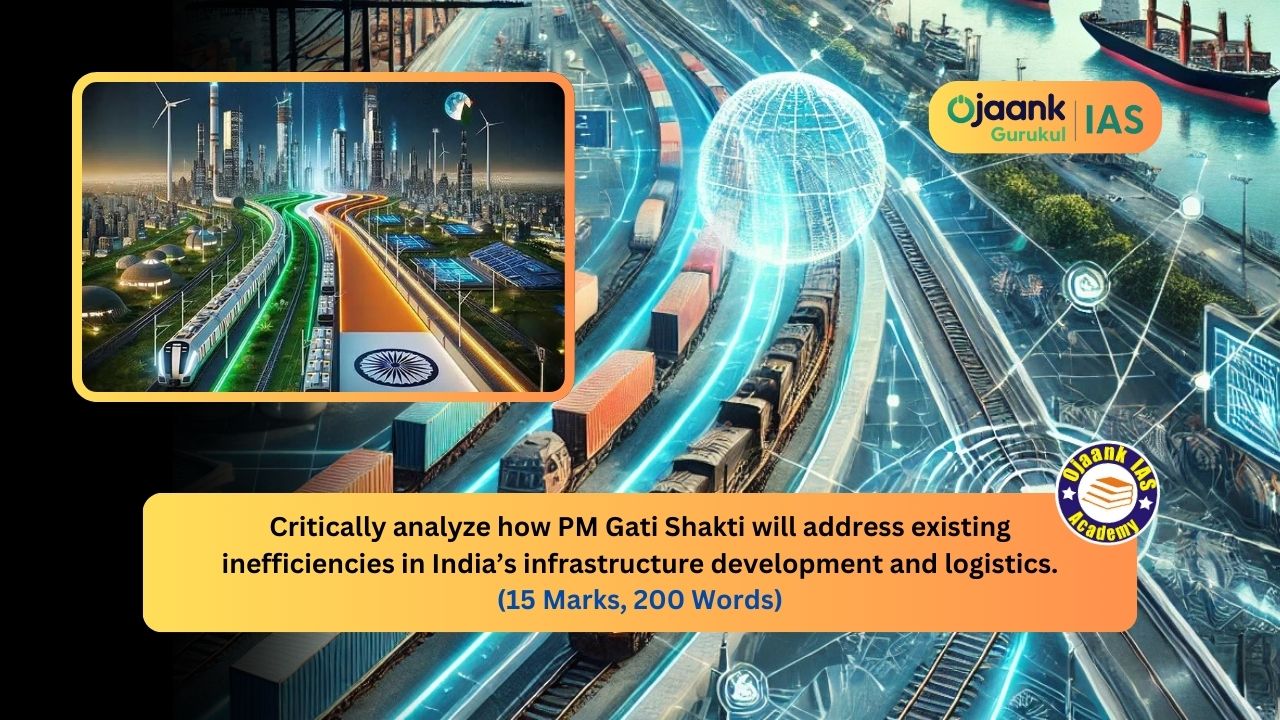Critically analyze how PM Gati Shakti will address existing inefficiencies in India’s infrastructure development and logistics. (15 Marks, 250 Words)

India’s infrastructure development and logistics sector have long been plagued by inefficiencies such as fragmented planning, high costs, and bureaucratic delays. The PM Gati Shakti initiative launched in 2021, aims to address these structural bottlenecks by leveraging technology, integrated planning, and streamlined approvals.
Current Inefficiencies in Infrastructure Development and Logistics
1. Fragmented Planning and Lack of Coordination
- Infrastructure projects often suffer from lack of coordination between departments, leading to delays and cost overruns.
2. High Logistics Costs
- India’s logistics costs account for 13-14% of GDP, compared to global benchmarks of 8-9%
3. Bureaucratic Bottlenecks
- Delays in approvals, lack of multimodal transport systems, and inefficiencies in supply chains hinder economic growth.
How PM Gati Shakti Addresses These Inefficiencies
1. Integrated Planning Through Digital GIS-Based Platform
- PM Gati Shakti integrates 13 key infrastructure sectors, including roads, railways, ports, and energy.
- GIS-based mapping ensures real-time tracking and coordinated development.
2. Reduction in Logistics Costs
- Seamless multimodal transport reduces delays, fuel costs, and inefficiencies in goods movement.
3. Streamlined Approval Processes
- A unified digital platform ensures quicker decision-making by cutting bureaucratic red tape.
4. Elimination of Redundancy in Infrastructure Projects
- Prevents duplication of efforts by synchronizing various departmental projects.
Key Impacts of PM Gati Shakti
1. Economic Growth
- Enhances productivity, improves trade efficiency, and boosts exports.
2. Promotion of Inclusive Development
- Connects rural areas to urban markets, ensuring balanced regional growth.
3. Employment Generation
- Infrastructure projects create direct and indirect job opportunities.
Challenges and Recommendations
1. Challenges
- Coordination among states, funding constraints, and the need for capacity-building in government agencies.
2. Recommendations
- Increase private-sector participation, improve regulatory frameworks, and ensure timely project reviews.
Conclusion
PM Gati Shakti is a transformative initiative that addresses longstanding inefficiencies in India's infrastructure and logistics sectors. By integrating planning, reducing logistics costs, and streamlining approvals, the initiative paves the way for enhanced economic growth, job creation, and regional development. However, successful implementation requires overcoming challenges related to coordination, funding, and capacity building. With sustained efforts, PM Gati Shakti can make India's infrastructure globally competitive and efficient.
FAQs
1. How does PM Gati Shakti improve coordination among different infrastructure projects?
PM Gati Shakti integrates 13 key infrastructure sectors using a digital GIS-based platform, ensuring real-time tracking and coordinated planning.
2. What impact will PM Gati Shakti have on India's logistics sector?
It aims to reduce logistics costs from 13-14% of GDP to global standards of 8-9%, enhancing efficiency and competitiveness.
3. How does PM Gati Shakti contribute to employment generation?
The initiative creates direct jobs in infrastructure projects and indirect employment in related industries, boosting overall economic growth.
4. What are the major challenges in implementing PM Gati Shakti?
Key challenges include coordination among states, funding constraints, and the need for capacity-building in government agencies.
5. How can private-sector participation enhance PM Gati Shakti’s success?
Public-private partnerships (PPPs) can provide financial resources, technical expertise, and efficient project management, ensuring timely completion.